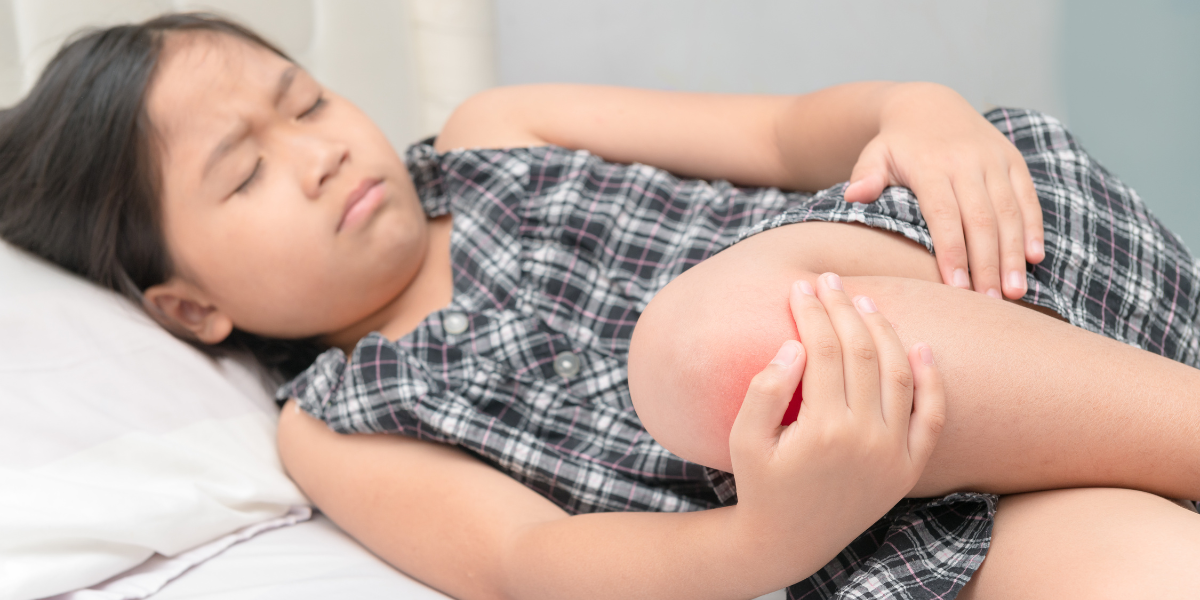What is Juvenile Idiopathic Arthritis (JIA)? What do I do if my child has JIA? For World Arthritis Day, we answer some common questions about JIA.
Juvenile Idiopathic Arthritis (JIA) is an autoimmune disease and is the most common type of arthritis in children and adolescents under the age of 17, affecting about one in 1,000 kids. In JIA, the body’s immune system, which normally defends the body from infection, mistakenly attacks healthy cells and tissues, causing pain, stiffness and inflammation in the joints.
There are several subtypes of JIA:
- Oligoarticular: affects one to four joints and is the most common subtype of JIA. The joints affected are usually the large joints, such as the knees, ankles and elbows.
- Polyarticular (rheumatoid factor positive or negative): affects five or more joints within the first six months of the disease and can often affect both large and small joints. This is the most severe form of JIA.
- Systemic onset: affects one or more joints and is often preceded by a high fever and skin rash. Internal organs may also become inflamed, including the heart, liver, spleen and lymph nodes.
- Psoriatic: involves arthritis and psoriasis, a skin disease that causes red, scaly patches. Kids with this form of arthritis may also have inflammation of fingers or toes, nail pitting and an increased risk of uveitis (eye inflammation).
- Enthesitis-related: involves inflammation of the joints and the tissue where bones and tendons or ligaments connect (entheses). It commonly affects the spine, hips, knees and feet.
- Undifferentiated: inflammation is present in one or more joints, but the child’s symptoms don’t necessarily match one type of JIA.
What causes JIA?
The cause of JIA is unknown, and there is no known way to prevent the disease. The disease sometimes runs in families, though not always. Genetics, infection and environmental factors are all believed to be involved, either in combination or separately, though specific environmental causes are unknown.

What are the main symptoms?
With JIA, your child may complain of pain and stiffness after sitting in school all day or that they’re having a challenging time participating in physical activities due to their discomfort. JIA typically causes joint pain and inflammation in the hands, elbows, wrists, knees and ankles. It can also affect other parts of the body and cause additional symptoms, including:
- Warmth and redness around the joints
- Decreased mobility, including stiffness that is often worse in the morning or after sitting or lying down for a prolonged period
- Weakened muscles and soft tissues around the joints
- Fever
- Rash
- Blurred vision, eye redness and pain
- Uveitis (eye inflammation)
- Weight loss
- Fatigue
- Irritability
What do I do if I suspect my child has JIA?
If your child’s joint pain, swelling or stiffness lasts more than a week, or you suspect your child is exhibiting some of the other symptoms of JIA, take them to see your family doctor or pediatrician. Your child’s doctor will also likely refer you to a pediatric rheumatologist to confirm a diagnosis of JIA.
A pediatric rheumatologist specializes in the care and treatment of conditions such as JIA and other autoimmune diseases in children and adolescents. Working with your child’s doctor, the rheumatologist will assess and treat your child throughout their journey with JIA.
How is it diagnosed?
Your physician will take your child’s medical history, perform a physical examination and order various laboratory tests. There are numerous tests used to diagnose JIA. Some common tests include:
- Blood tests: to detect the presence of antinuclear antibodies and rheumatoid factor (proteins found in the blood) and measure the degree of inflammation in the body. These can also help rule out other diseases as potential causes for your child’s symptoms.
- Imaging: x-rays, ultrasound or magnetic resonance imaging (MRI) to rule out injury or other conditions and see if there is any joint damage.
How is it treated?

“Early diagnosis and treatment of JIA are very important, because with current treatments, the disease can be fully controlled in almost all patients, preventing permanent damage and disability,” says Dr. Jaime Guzman, BC Children’s Hospital investigator and pediatric rheumatologist.
Individualized treatment is important for JIA, as each child is different, and their treatment will vary depending on the type and severity of JIA. There are many different treatment options, including medication and physical therapy. Medications can decrease pain and swelling, improve mobility and prevent potential joint damage. Some medications used in treating JIA include:
- Nonsteroidal anti-inflammatory drugs (NSAIDs): reduce pain and swelling
- Disease-modifying antirheumatic drugs (DMARDs): slow or stop the progression of the disease by suppressing the immune system
- Biologics: target molecules or proteins in the immune system to reduce inflammation and prevent joint damage
- Corticosteroids: target inflammation and are typically used to control symptoms until other medications start working
Other treatment options for JIA can include physical therapy to maintain your child’s flexibility and range of motion. Healthy lifestyle habits like getting enough exercise, sleep and eating a well-balanced, nutritious diet can also help manage symptoms.
Are there other ways I can support my child?
It’s important to have open communication not only with your child and their care team, but also their teachers, coaches and other caregivers to make sure everyone understands your child’s needs and is able to make the necessary accommodations to help your child manage their symptoms.
Your child’s mental health — and yours — is important. If your child is struggling with their symptoms and their mental health, visiting a therapist can be helpful. In addition, many families find it beneficial to connect with other families dealing with JIA and participate in support groups. Knowing someone else who is going through the same experiences can be extremely helpful.
Will my child recover from JIA?
Treatment is highly effective for most kids diagnosed with JIA, allowing them to live normal lives. According to recent research, the disease is fully controlled within the first year of treatment for about 75 per cent of children and adolescents with JIA. While symptom flare-ups are common afterwards, they tend to be mild and can be managed with medications. Your child may be able to reduce or discontinue medication after experiencing remission. However, in some cases, your child will still need medication to manage symptoms depending on the type and severity of their JIA.

Some children and adolescents with JIA will be diagnosed with a different type of arthritis in adulthood such as rheumatoid arthritis. However, since the majority of children with JIA respond well to treatment, there is reason to be optimistic about your child’s future. A solid treatment plan while transitioning from adolescence to adulthood can go a long way to managing pain and other symptoms.
“Research has improved treatments for JIA and provided answers to many questions parents have to help their children manage their disease,” says Dr. Guzman. “With current treatments, most children with JIA lead normal productive lives.”
Visit the Division of Rheumatology website to learn more about JIA and other rheumatology research.




